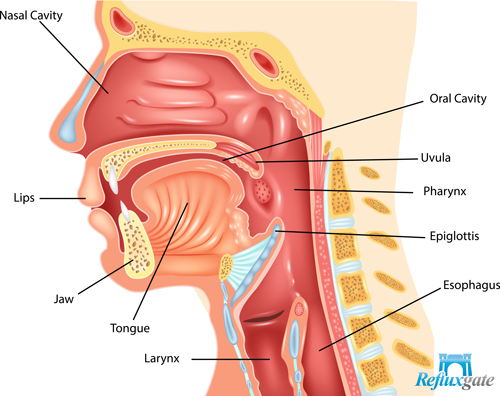LPR causes inflammation in every part of the airways.
Usually, the LPR starts to show with one or a few of the symptoms.
The longer you let the disease progress, the more additional LPR symptoms you will see. That is why it is so crucial to stop the disease early.
The 10 Telltale LPR Symptoms
LPR is caused by gaseous reflux. Little droplets that contain acid, bile, and most importantly, the stomach enzyme pepsin. They spread in your airways during inhaling and exhaling. That is why LPR is sometimes called airway reflux or respiratory reflux.
Not everybody with LPR shows the same symptoms. Our bodies are all made slightly different. We all have different weak spots. One person might have strong defenses against the damage of reflux in the throat. But he might have weak reflux protection in the lung. That person would likely get asthma or a cough first and other symptoms later.
1. Hoarseness

Hoarseness and discomfort when speaking are typical symptoms of LPR.
The cause is reflux laryngitis, an inflammation of the larynx caused by reflux.
The larynx is the organ that we create our voice with. It is located directly next to the esophagus. Each time we have reflux, stomach gases travel up through the esophagus and hit the larynx before they spread into the airways.
That is why most LPR patients develop hoarseness sooner or later. Often it is the first symptom they show.
2. Asthma and Respiratory Problems
Multiple experts I have interviewed were convinced that reflux is the reason why the number of asthmatics has increased in recent years.
According to Dr. Jamie Koufman from the voice institute of New York, it is extremely important to examine whether asthmatics have difficulty breathing in or out. Problems with exhalation are a typical sign of normal asthma, while problems with inhalation indicate laryngopharyngeal reflux.
3. Excessive Mucus Formation in Throat and Airways
The constant irritation and inflammation of the mucous membranes leading to increased secretion of mucus.
4. Continuous need to clear one’s throat
Like during a cold, the constant irritation and the excess mucus triggers a host of other symptoms. Throat clearing is one of them.
5. Chronic Cough
Cough is another very common symptom of LPR.
All the excess mucus would block our breathing if we couldn’t clear our airways by coughing. Like with throat-clearing, the cough is a reaction to the overproduction of mucus.
6. Post-Nasal Drip
If LPR causes inflammation of your sinuses or nasal cavities, mucus production is increased there as well.
All that mucus has to go somewhere. Usually, it will drip down the back of your throat which is called a post-nasal drip.
7. A Lump in the Throat (Globus Syndrome)
Some of those affected with LPR report that they feel like they have a lump in their throat. Or a feeling of tightness. It might feel like something is stuck there.
The reason can be LPR. The throat can swell which causes this lump-like feeling. Another reason is that the valve between the esophagus and the throat becomes stressed and tense from reflux. It tries to press together as hard as it can to limit the reflux. This causes the lump-like feeling. You can still get the other LPR symptoms despite that. Even if the valve presses hard, it cannot block all the gaseous reflux.
In medicine, this lump-like feeling is called globus syndrome. In the past, patients with this problem were told it is all in their head. Now we know better. It is a symptom of laryngopharyngeal reflux.
8. Difficulties swallowing
Swallowing difficulties go hand in hand with the globus syndrome.
Usually, the valve in your throat would need to relax when you swallow and get tight again afterward. If the valve is tense and stressed from LPR, that won’t work very well. Swallowing becomes difficult.
If you fix your LPR, your swallowing will go back to normal as well.
9. Frequent Belching
Many patients with LPR experience frequent belching.
10. Ear infections
Sounds crazy, but LPR can even cause symptoms in the ears.
The reason is simple: the so-called eustachian tube connects our ears to the airways. Gaseous reflux can travel through that tube and cause inflammation.
Children are affected by this quite often. Their eustachian tube is not yet fully developed.
Amplification of Existing Airway Diseases
If you already have another problem in the airways, LPR will cause you more trouble than it would somebody else.
Remember when we talked above about LPR always hitting the weak spots first? If you have a pollen allergy, real asthma or something similar, then the airways are already weakened. They are prone to irritation and inflammation.
Having multiple diseases can obscure that you have LPR in the first place. Some people wonder why they have such an insanely strong pollen allergy. The reality might be that they have some pollen allergy and laryngopharyngeal reflux on top, amplifying each other’s symptoms.
Other Laryngopharyngeal Reflux Symptoms
The above symptoms are just the most common ones. There are more. LPR causes inflammation in all your airways. So, if you have an airway symptom that is based on inflammation, it can be caused by laryngopharyngeal reflux. Latest research indicates that reflux can even get all the way to the eyes and trigger dry eye symptoms.
Of course, that does not make it easier to diagnose LPR correctly. If pretty much any symptom in your airways could be LPR, how do you find out whether you have the disease or not?
How to Diagnose LPR
There is one thing that is very typical for LPR. You usually do not have one symptom alone. Instead, you get multiple ones.
The combination of symptoms helps a lot to make the diagnosis. But it is also something that can lead to confusion even among physicians, if they are not specialized in LPR.
Luckily, researchers and physicians have developed an easy questionnaire to help with that. It is called the reflux-symptom-score, RSI for short.
The RSI tells you how likely it is that you have LPR. I have digitalized the test for you. It takes just a few minutes to answer the questions.

